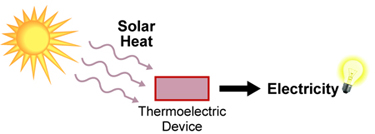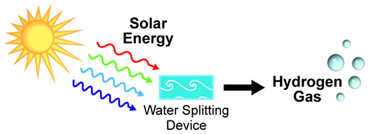
The Center for Solar Energy was established in 2007 to pioneer research in solar energy conversion. Presently, solar energy provides an insignificant fraction (<<1%) of the United States' overall energy needs, and fundamental scientific breakthroughs will be required to change this state of affairs.
Mission
The mission of the Center for Solar Energy (CfSE) is to study the fundamental scientific principles of solar energy conversion and to educate scientists, students, and the general public about harnessing our most abundant energy resource.
Solar to Electric Power Generation
Photovoltaics (PV) or solar cells directly convert the energy from the sun to direct current (DC) electricity. Researchers in the CfSE are looking into ways to develop cheap, easy to manufacture, and high efficiency solar cells. Fundamental insights and new materials and design developments will help drive down the cost barrier for large-scale implementation.

Solar Heat to Electric Power Generation
Thermoelectrics (TE) directly convert heat to electricity. These devices can utilize wasted solar heat as well as wasted heat from other sources like car braking, making this technology very exciting for many areas of the clean energy sector. Researchers in the CfSE are studying the fundamental obstacles that limit the efficiency in these devices as well as developing interesting new nano-scale morphologies and materials.

Water Splitting for Chemical Fuel Production
Photoelectrochemical water splitting uses the energy from the sun to directly split water molecules (H2O) into hydrogen (H2) and oxygen (O2) gas. Chemical fuels, such as hydrogen, have very high energy densities making them ideal for transportation and energy storage. Researchers in the CfSE are looking into new approaches to split water. This includes designing new molecules based on photosynthesis and synthesizing unique nanostructures.

Enabling Technologies for Solar Energy
There are several important technologies and science areas that complement the above research areas. This includes hydrogen sensing needed for a hydrogen economy, micro-inverters to efficiently convert DC electricity generated by PV and TE devices to AC electricity you use in your home, and batteries for energy storage.